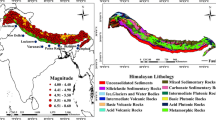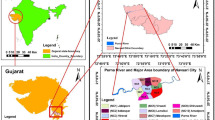Abstract
Worldwide, earthquakes and related disasters have persistently had severe negative impacts on human livelihoods and have caused widespread socioeconomic and environmental damage. The severity of these disasters has prompted recognition of the need for comprehensive and effective disaster and emergency management (DEM) efforts, which are required to plan, respond to and develop risk mitigation strategies. In this regard, recently developed methods, known as multi-criteria decision analysis (MCDA), have been widely used in DEM domains by emergency managers to greatly improve the quality of the decision-making process, making it more participatory, explicit, rational and efficient. In this study, MCDA techniques of the Analytical Hierarchical Process (AHP) and the Technique for Order Preference by Similarity to Ideal Solution (TOPSIS), integrated with GIS, were used to produce earthquake hazard and risk maps for earthquake disaster monitoring and analysis for a case study region of Küçükçekmece in Istanbul, Turkey. The five main criteria that have the strongest influence on the impact of earthquakes on the study region were determined: topography, distance to epicentre, soil classification, liquefaction and fault/focal mechanism. AHP was used to determine the weights of these parameters, which were also used as input into the TOPSIS method and GIS (ESRI ArcGIS) for simulating these outputs to produce earthquake hazard maps. The resulting earthquake hazard maps created by both the AHP and TOPSIS models were compared, showing high correlation and compatibility. To estimate the elements at risk, population and building data were used with the AHP and TOPSIS hazard maps for potential loss assessment; thus, we demonstrated the potential of integrating GIS with AHP and TOPSIS in generating hazard maps for effective earthquake disaster and risk management.







Similar content being viewed by others
References
Ambraseys NN (1995) The prediction of earthquake peak ground acceleration in Europe. Earthq Eng Struct Dyn 24(4):467–490
Behzadian M, Otaghsara SK, Yazdani M, Ignatius J (2012) A state-of the-art survey of TOPSIS applications. Expert Syst Appl 39(17):13051–13069
Bhushan N, Rai K (2004) Strategic decision making: apply the analytical hierarchy process. Springer, London
Boore DM, Joyner WB, Fumal TE (1997) Equations for estimating horizontal response spectra and peak acceleration from western North American earthquakes: a summary of recent work. Seismol Res Lett 68(1):128–153
Boran FE, Genç S, Kurt M, Akay D (2009) A multi-criteria intuitionistic fuzzy group decision making for supplier selection with TOPSIS method. Expert Syst Appl 36(8):11363–11368
Çetinkaya C, Özceylan E, Erbaş M, Kabak M (2016) GIS-based fuzzy MCDA approach for siting refugee camp: a case study for southeastern Turkey. Int J Disaster Risk Reduct 18:218–231
Chen CT (2000) Extensions of the TOPSIS for group decision-making under fuzzy environment. Fuzzy Sets Syst 114(1):1–9
Chen K, Blong R, Jacobson C (2003) Towards an integrated approach to natural hazards risk assessment using GIS: with reference to bushfires. Environ Manag 31(4):0546–0560
Chu TC, Lin YC (2002) Improved extensions of the TOPSIS for group decision making under fuzzy environment. J Inf Optim Sci 23(2):273–286
Dharmarajan R, Sharmila C (2016) The evaluation of topsis and fuzzy-topsis method for decision making system in data mining. Int Res J Eng Technol (IRJET) 3:9
EM-DAT (2016) International disaster database. Catholic University of Louvain: Brussels, Belgium. http://www.emdat.be. Accessed 20 Mar 2017
Erden T (2012) Disaster and emergency management activities by geospatial tools with special reference to Turkey. Disaster Adv 5(1):29–36
Erden T, Coskun MZ (2010) Multi-criteria site selection for fire services: the interaction with analytic hierarchy process and geographic information systems. Nat Hazard Earth Syst 10(10):2127–2134. https://doi.org/10.5194/nhess-10-2127-2010
Erden T, Karaman H (2012) Analysis of earthquake parameters to generate hazard maps by integrating AHP and GIS for Küçükçekmece region. Nat Hazard Earth Syst 12(2):475–483
Erdik M, Doyuran V, Akkaş N, Gülkan P (1985) A probabilistic assessment of the seismic hazard in Turkey. Tectonophysics 117(3–4):295–344
Ferretti V (2011) Integrating Multicriteria Analysis and Geographic Information Systems: a survey and classification of the literature. In: 74th meeting of the European working group “multiple criteria decision aiding”
Hwang CL, Yoon K (1981) Methods for multiple attribute decision-making. In: Beckmann M, Künzi HP (eds) Multiple attribute decision making. Springer, Berlin, pp 58–191
Karaman H, Erden T (2014) Net earthquake hazard and elements at risk (NEaR) map creation for city of Istanbul via spatial multi-criteria decision analysis. Nat Hazards. https://doi.org/10.1007/s11069-014-1099-2
Krohling RA, Campanharo VC (2011) Fuzzy TOPSIS for group decision making: a case study for accidents with oil spill in the sea. Expert Syst Appl 38(4):4190–4197
Malczewski J (1996) A GIS-based approach to multiple criteria group decision-making. Int J Geogr Inf Syst 10(8):955–971
Malczewski J (1999) GIS and multicriteria decision analysis. Wiley, New York
Malczewski J (2006) GIS-based multicriteria decision analysis: a survey of the literature. Int J Geogr Inf Sci 20(7):703–726
Malczewski J, Rinner C (2015) Multicriteria decision analysis in geographic information science. Springer, Berlin
Maliki A, Owen G, Bruce D (2012) Combining AHP and TOPSIS approaches to support site selection for a lead pollution study. In: 2nd international conference on environmental and agriculture engineering IPCBEE 37 IACSIT Press, Singapore
Marza VI (2004) On the death toll of the 1999 Izmit (Turkey) major earthquake. ESC General Assembly Papers, European Seismological Commission, Potsdam
Najafabadi RM, Ramesht MH, Ghazi I, Khajedin SJ, Seif A, Nohegar A, Mahdavi A (2016) Identification of natural hazards and classification of urban areas by TOPSIS model (case study: Bandar Abbas city, Iran). Geomat Nat Hazards Risk 7(1):85–100
Nyimbili PH, Erden T (2018) Spatial decision support systems (SDSS) and software applications for earthquake disaster management with special reference to Turkey. Nat Hazards 90(3):1485–1507. https://doi.org/10.1007/s11069-017-3089-7
Ozturk D, Batuk F (2011) Technique for order preference by similarity to ideal solution (TOPSIS) for spatial decision problems. In: Proceedings ISPRS
Parsons T (2004) Recalculated probability of M ≥ 7 earthquakes beneath the Sea of Marmara. Turk J Geophys Res Solid Earth 1978–2012:109
Pereira JM, Duckstein L (1993) A multiple criteria decision-making approach to GIS-based land suitability evaluation. Int J Geogr Inf Sci 7(5):407–424
Pirdavani A, Brijs T, Geert W (2009) A multiple criteria decision making approach for prioritizing accident hotspots in the absence of crash data. Transp Rev 30(1):97–113
Qin X (2013) Local ideal point method for gis-based multicriteria analysis: a case study in London, Ontario (Master’s Thesis). University of Western Ontario, Canada
Rao RV (2007) Decision making in the manufacturing environment: using graph theory and fuzzy multiple attribute decision making methods. Springer, London
Rashed T, Weeks J (2003) Assessing vulnerability to earthquake hazards through spatial multicriteria analysis of urban areas. Int J Geogr Inf Sci 17(6):547–576
Roshan G, Ghanghermeh A, Grab SW (2018) Testing a new application for TOPSIS: monitoring drought and wet periods in Iran. Theor Appl Climatol 131(1–2):557–571
Saaty TL (1980) The analytic hierarchy process: planning setting priorities, resource allocation. McGraw-Hill, New York
Sánchez-Lozano JM, Teruel-Solano J, Soto-Elvira PL, García-Cascales MS (2013) Geographical Information Systems (GIS) and Multi-Criteria Decision Making (MCDM) methods for the evaluation of solar farms locations: case study in South-Eastern Spain. Renew Sustain Energy Rev 24:544–556
Sarvar H, Amini J, Laleh-Poor M (2011) Assessment of risk caused by earthquake in region 1 of Tehran using the combination of RADIUS, TOPSIS and AHP models. J Civ Eng Urban 1:39–48
Smyth AW, Altay G, Deodatis G, Erdik M, Franco G, Gülkan P, Yüzügüllü O (2004) Probabilistic benefit-cost analysis for earthquake damage mitigation: evaluating measures for apartment houses in Turkey. Earthq Spectra 20(1):171–203
Sugumaran R, DeGroote J (2011) Spatial decision support systems: principles and practices. CRC Press, Boca Raton
Vaidya OS, Kumar S (2006) Analytic hierarchy process: an overview of applications. Eur J Oper Res 169(1):1–29
Voogd H (1982) Multicriteria evaluation with mixed qualitative and quantitative data. Environ Plan 9(2):221–236
Wang YM, Elhag TM (2006) Fuzzy TOPSIS method based on alpha level sets with an application to bridge risk assessment. Expert Syst Appl 31(2):309–319
Wang TC, Lee HD (2009) Developing a fuzzy TOPSIS approach based on subjective weights and objective weights. Expert Syst Appl 36(5):8980–8985
Yagoub MM (2015) Spatio-temporal and hazard mapping of Earthquake in UAE (1984–2012): remote sensing and GIS application. Geoenviron Disasters 2(1):13
Zeleny M (1982) Multiple criteria decision making. McGraw Hill, New York
Author information
Authors and Affiliations
Corresponding author
Electronic supplementary material
Below is the link to the electronic supplementary material.
Online Resource 1
ArcGIS python script for AHP Model in ModelBuilder (PY 9 kb)
Online Resource 2
ArcGIS python script for TOPSIS Model in ModelBuilder (PY 20 kb)
Rights and permissions
About this article
Cite this article
Nyimbili, P.H., Erden, T. & Karaman, H. Integration of GIS, AHP and TOPSIS for earthquake hazard analysis. Nat Hazards 92, 1523–1546 (2018). https://doi.org/10.1007/s11069-018-3262-7
Received:
Accepted:
Published:
Issue Date:
DOI: https://doi.org/10.1007/s11069-018-3262-7




